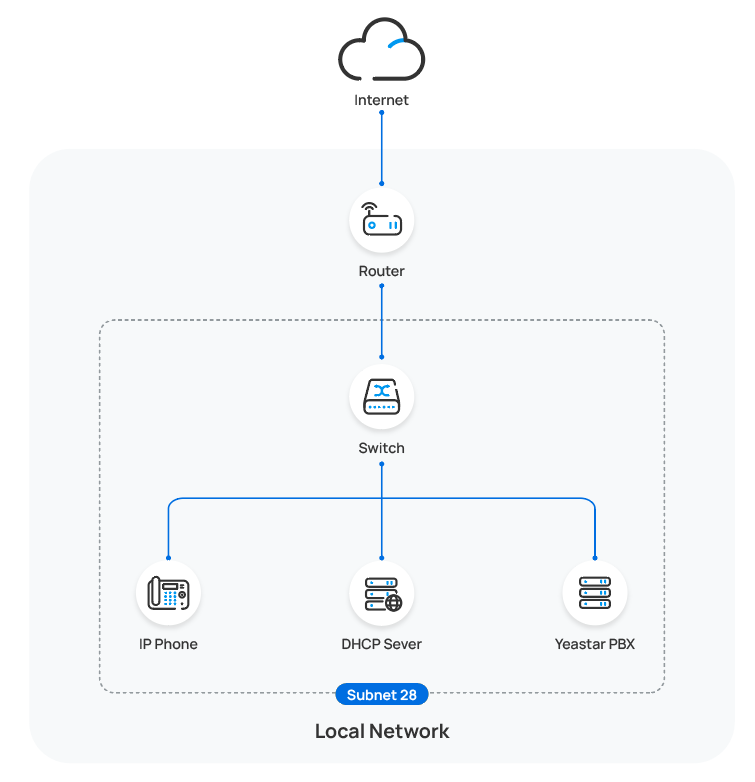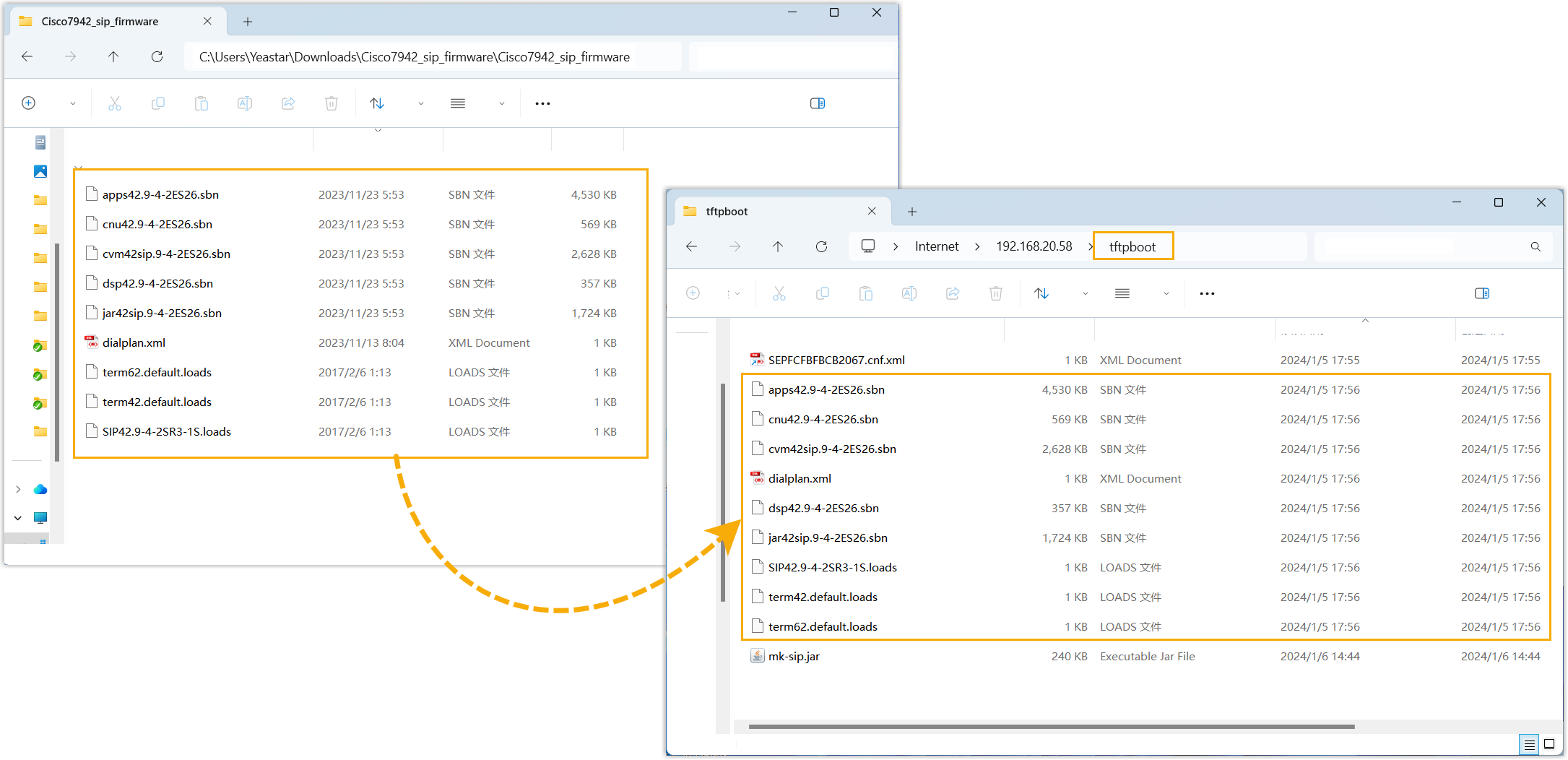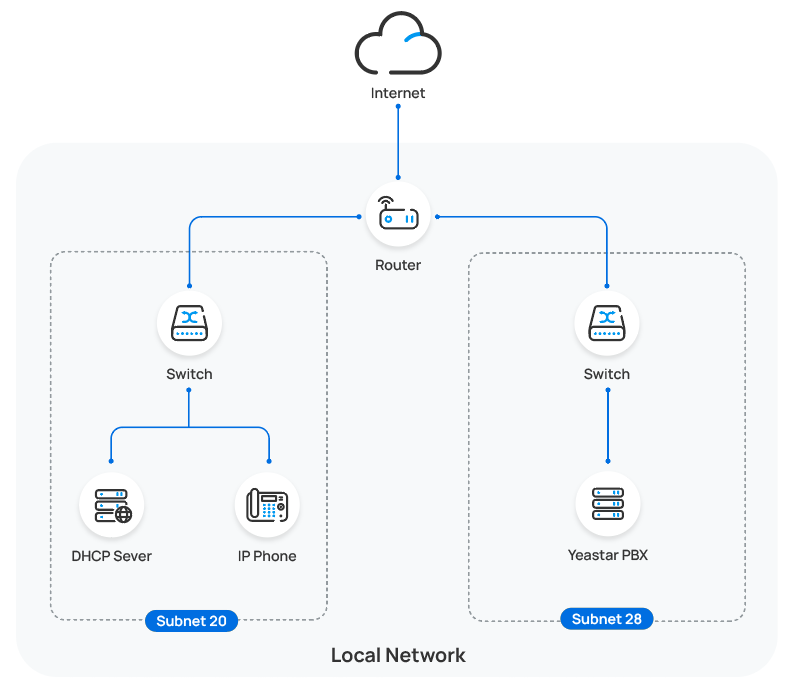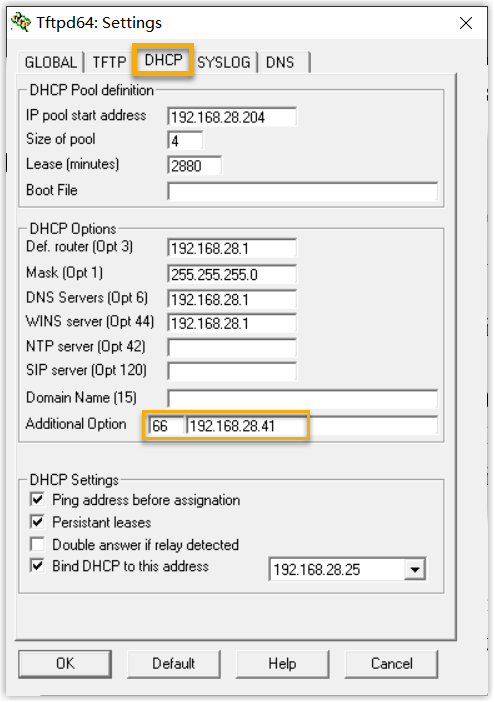Auto Provision Cisco IP Phone with Yeastar P-Series PBX System
This topic describes how to auto provision Cisco IP phone with Yeastar P-Series PBX System in Local Area Network (LAN), so as to associate the Cisco IP phone with a Yeastar PBX extension.
Requirements
The firmwares of Cisco IP phone and Yeastar PBX meet the following requirements.
| Model | Phone Requirement | PBX Requirement | Supported Auto Provisioning Method |
|---|---|---|---|
| 3905 | 9.4(1)SR3 or later |
37.12.0.23 or later |
|
| 6921 | SCCP69xx.9-4-1-3SR4-1 or later |
37.17.0.17 or later |
|
| 6941 | SCCP69xx.9-4-1-3SR4-1 or later |
37.17.0.17 or later |
|
| 6961 | SCCP69xx.9-4-1-3SR4-1 or later |
37.17.0.17 or later |
|
| 7811 | sip78xx.14-2-1-0001-455 or later |
37.17.0.17 or later |
|
| 7821 | 14.2(1)SR1 or later |
37.12.0.23 or later |
|
| 7841 | sip78xx.14-2-1-0001-455 or later |
37.17.0.17 or later |
|
| 7851 | sip78xx.14-2-1-0001-455 or later |
37.17.0.17 or later |
|
| 7861 | SIP78xx.14-2-1-0201-40 or later |
37.13.0.29 or later |
|
| 7911 | SIP11.9-2-1S or later |
37.17.0.17 or later |
|
| 7925 | CP7925G-1.4.5.3.loads or later |
37.17.0.17 or later |
|
| 7942 | SIP42.9-4-2SR3-1S or later |
37.12.0.23 or later |
|
| 7945 | SIP45.9-4-2SR4-1S or later |
37.17.0.17 or later |
|
| 7962 | SIP42.9-4-2SR4-1S or later |
37.17.0.17 or later |
|
| 7975 | SIP75.9-3-1SR4-1S or later |
37.17.0.17 or later |
|
| 8811 | SIP88xx.12-1-1SR1-4 or later |
37.13.0.29 or later |
|
| 8841 | 14.3(1)SR3 or later |
37.13.0.29 or later |
|
| 8845 | 14.2(1)SR1 or later |
37.12.0.23 or later |
|
| 8851 | sip88xx.14-2-1-0001-455 or later |
37.17.0.17 or later |
|
| 8861 | sip88xx.14-2-1-0001-455 or later |
37.17.0.17 or later |
|
| 8865 | sip88xx.14-2-1-0001-455 or later |
37.17.0.17 or later |
|
| 8941 | sip89xx.9-4-2SR4-1 or later |
37.17.0.17 or later |
|
| 8945 | sip89xx.9-4-2SR4-1 or later |
37.17.0.17 or later |
|
| 8961 | sip89xx.9-4-2SR4-1 or later |
37.17.0.17 or later |
|
| 9951 | sip99xx.9-4-2SR4-1 or later |
37.17.0.17 or later |
|
| 9971 | sip99xx.9-4-2SR4-1 or later |
37.17.0.17 or later |
|
| SPA501G | 7.4.7 or later |
37.19.0.110 or later |
|
| SPA502G | 7.4.7 or later |
37.19.0.110 or later |
|
| SPA504G | 7.4.7 or later |
37.19.0.110 or later |
|
| SPA508G | 7.4.7 or later |
37.19.0.110 or later |
|
| SPA509G | 7.4.7 or later |
37.19.0.110 or later |
|
| SPA512G | 7.4.7 or later |
37.19.0.110 or later |
|
| SPA514G | 7.4.7 or later |
37.19.0.110 or later |
|
| SPA301 | 7.4.7 or later |
37.19.0.110 or later |
|
| SPA303 | 7.4.7 or later |
37.19.0.110 or later |
|
| SPA525G2 | 7.4.7 or later |
37.19.0.110 or later |
|
Scenarios
Yeastar P-Series PBX System supports to auto provision Cisco IP phone via DHCP method in local network. The provisioning operations vary depending on the network environment of Cisco IP phone and Yeastar PBX.
Auto provision a Cisco IP phone in the same subnet
In this example, the Cisco IP phone, a DHCP server, and the Yeastar PBX (IP:
192.168.28.41) are deployed in subnet 28.

- Prerequisites
-
- Make sure that there is only one DHCP server running in the subnet, or the IP phone would fail to obtain an IP address.
- Make sure that you have downloaded the template for the desired phone model (Path: ).
- Gather information of IP phone, including Vendor, Model, and MAC address.
- (Optional)
Download
your desired language files from Cisco
website and upload
the language files to the folder
tftpbootin the PBX via FTP.Note: By default, Cisco IP phone displays in English. If you want it to display in another language after auto provisioning, you can manually upload your language files to PBX.
- If you want to provision Cisco 7942, in
addition to the above prerequisites, you will also need to
complete the followings:
- Download and extract the Cisco 7942
provisioning package, and put the extracted
files into the folder
tftpbootof the PBX.
- Disable NAT for the extension on PBX web portal (Path: ).

- Download and extract the Cisco 7942
provisioning package, and put the extracted
files into the folder
- Procedure
- Step 1. Enable the TFTP feature on PBX
- When provisioning a Cisco IP phone, the PBX works as a TFTP server to host the phone's configuration file. You need to enable the TFTP feature on PBX, so that the IP phone can download configurations from the PBX via TFTP.
- Step 2. Add the Cisco IP phone on PBX
-
Add the IP phone on PBX. The PBX will generate a configuration file based on the phone's MAC address.
- On PBX web portal, go to .
- Click .
- In the IP Phone section, enter the
following phone information.

- Vendor: Select Cisco.
- Model: Select the phone model.
- MAC Address: Enter the MAC address of the IP phone.
- In the Options section, configure the
following settings.

- Template: Select a desired template
from the drop-down list.Note: You can select the default template corresponding to the phone model, or customize your own template. For more information, see Create a Custom Auto Provisioning Template.
- Provisioning Method: Select
DHCP (In the Office).
A provisioning link is automatically generated and displayed in the Provisioning Link field. This provisioning link points to the location where the phone's configuration file is stored.
- Template: Select a desired template
from the drop-down list.
- In the Assign Extension
section, assign an extension to the IP phone.
 Note: If your desired extension is not listed in the drop-down list, it indicates that the extension has been associated with an IP phone or gateway.
Note: If your desired extension is not listed in the drop-down list, it indicates that the extension has been associated with an IP phone or gateway.- To release the extension from the associated IP phone or gateway, see Release an Extension from a Provisioned IP Phone/Gateway.
- To assign the extension to the phone without releasing it from the previously associated device, you can configure the concurrent registration setting for the extension, as the PBX only allows an extension to register with one SIP endpoint by default.
- Click Save.
- Step 3. Configure DHCP option 66 on DHCP server
- Configure the DHCP option 66 on the DHCP server to deliver the PBX's IP address.
- Step 4. (Optional) Reset the Cisco IP phone
- If the IP phone is to be deployed for a new user, you need to
reset the phone to its default settings to ensure that the
configurations from the previous user are removed from the phone.
- On the IP phone, press the
 button.
button. - On the IP phone screen, go to .
- Select Reset when the phone prompts for confirmation.
- On the IP phone, press the
- Result
-
- After boot-up, the IP phone gets an IP address from the DHCP server, downloads configurations from the PBX via TFTP protocol, and applies the settings automatically.
- The extension is successfully registered on the IP phone.
You can check the registration status on on the PBX web portal.

Auto provision a Cisco IP phone in different subnets
In this example, the Cisco IP phone and DHCP server are deployed in subnet 20, while
the Yeastar PBX (IP address: 192.168.28.41) is deployed in subnet
28.

- Prerequisites
-
- Make sure that there is only one DHCP server running in the subnet where the IP phone is deployed, or the IP phone would fail to obtain an IP address.
- Make sure that the IP phone and PBX can communicate with each other over the subnets.
- Make sure that you have downloaded the template for the desired phone model (Path: ).
- Gather information of IP phone, including Vendor, Model, and MAC address.
- (Optional)
Download
your desired language files from Cisco
website and upload
the language files to the folder
tftpbootin the PBX via FTP.Note: By default, Cisco IP phone displays in English. If you want it to display in another language after auto provisioning, you can manually upload your language files to PBX.
- If
you want to provision Cisco 7942,
you will also need to download and extract the Cisco7942 provisioning
package, and put the extracted files into the
folder
tftpbootof the PBX.
- Procedure
- Step 1. Enable the TFTP feature on PBX
- When provisioning a Cisco IP phone, the PBX works as a TFTP server to host the phone's configuration file. You need to enable the TFTP feature on PBX, so that the IP phone can download configurations from the PBX via TFTP.
- Step 2. Enable the Remote Registration feature for the extension on PBX
- Enable the Remote Registration feature for the extension to be assigned to the phone, so that the extension can be registered in a different subnet.
- Step 3. Add the Cisco IP phone on PBX
-
Add the IP phone on PBX. The PBX will generate a configuration file based on the phone's MAC address.
- On PBX web portal, go to .
- Click .
- In the IP Phone section, enter the
following phone information.

- Vendor: Select Cisco.
- Model: Select the phone model.
- MAC Address: Enter the MAC address of the IP phone.
- In the Options section, configure the
following settings.

- Template: Select a desired template
from the drop-down list.Note: You can select the default template corresponding to the phone model, or customize your own template. For more information, see Create a Custom Auto Provisioning Template.
- Provisioning Method: Select
DHCP (In the Office).
A provisioning link is automatically generated and displayed in the Provisioning Link field. This provisioning link points to the location where the phone's configuration file is stored.
- Template: Select a desired template
from the drop-down list.
- In the Assign Extension
section, assign an extension to the IP phone.
 Note: If your desired extension is not listed in the drop-down list, it indicates that the extension has been associated with an IP phone or gateway.
Note: If your desired extension is not listed in the drop-down list, it indicates that the extension has been associated with an IP phone or gateway.- To release the extension from the associated IP phone or gateway, see Release an Extension from a Provisioned IP Phone/Gateway.
- To assign the extension to the phone without releasing it from the previously associated device, you can configure the concurrent registration setting for the extension, as the PBX only allows an extension to register with one SIP endpoint by default.
- Click Save.
- Step 4. Configure DHCP option 66 on DHCP server
- Configure the DHCP option 66 on the DHCP server to deliver the PBX's IP address.
- Step 5. (Optional) Reset the Cisco IP phone
- If the IP phone is to be deployed for a new user, you need to
reset the phone to its default settings to ensure that the
configurations from the previous user are removed from the phone.
- On the IP phone, press the
 button.
button. - On the IP phone screen, go to .
- Select Reset when the phone prompts for confirmation.
- On the IP phone, press the
- Result
-
- After boot-up, the IP phone gets an IP address from the DHCP server, downloads configurations from the PBX via TFTP protocol, and applies the settings automatically.
- The extension is successfully registered on the IP phone.
You can check the registration status on on the PBX web portal.



